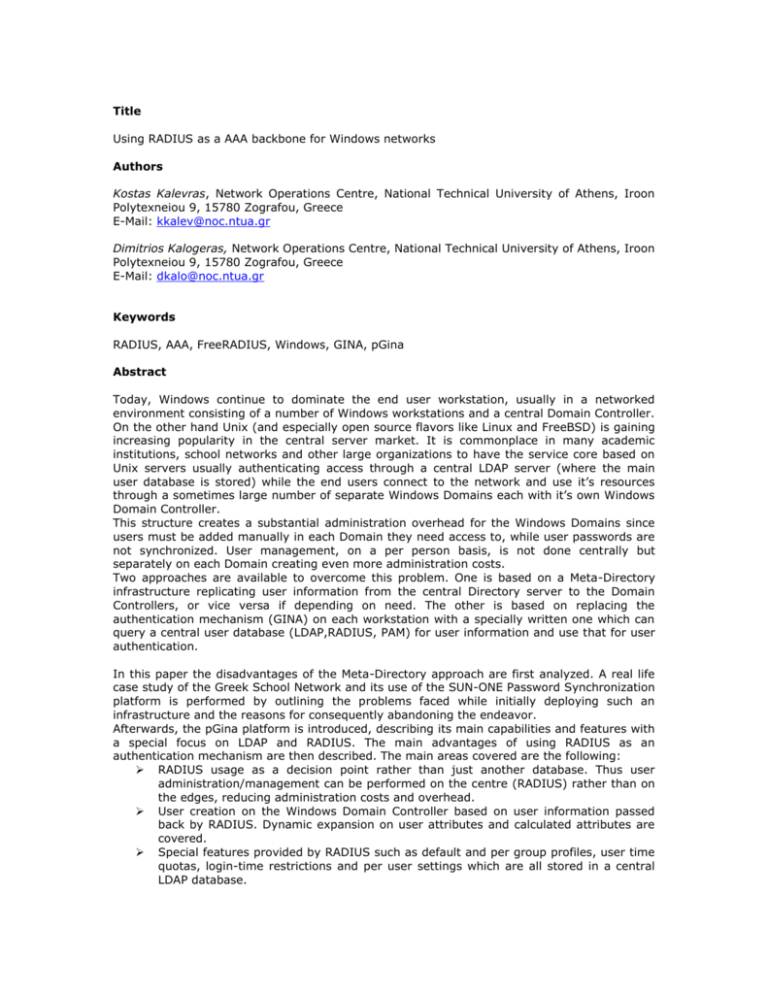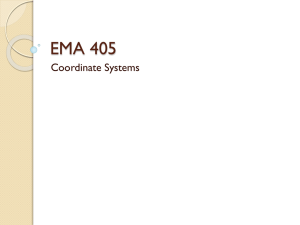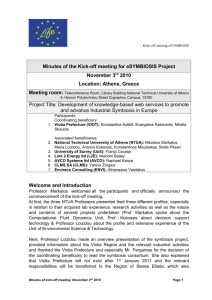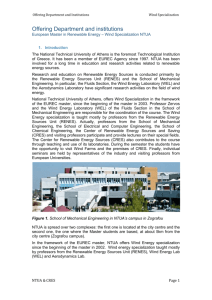Using RADIUS as a AAA backbone for Windows Networks, Poznan
advertisement

Title Using RADIUS as a AAA backbone for Windows networks Authors Kostas Kalevras, Network Operations Centre, National Technical University of Athens, Iroon Polytexneiou 9, 15780 Zografou, Greece E-Mail: kkalev@noc.ntua.gr Dimitrios Kalogeras, Network Operations Centre, National Technical University of Athens, Iroon Polytexneiou 9, 15780 Zografou, Greece E-Mail: dkalo@noc.ntua.gr Keywords RADIUS, AAA, FreeRADIUS, Windows, GINA, pGina Abstract Today, Windows continue to dominate the end user workstation, usually in a networked environment consisting of a number of Windows workstations and a central Domain Controller. On the other hand Unix (and especially open source flavors like Linux and FreeBSD) is gaining increasing popularity in the central server market. It is commonplace in many academic institutions, school networks and other large organizations to have the service core based on Unix servers usually authenticating access through a central LDAP server (where the main user database is stored) while the end users connect to the network and use it’s resources through a sometimes large number of separate Windows Domains each with it’s own Windows Domain Controller. This structure creates a substantial administration overhead for the Windows Domains since users must be added manually in each Domain they need access to, while user passwords are not synchronized. User management, on a per person basis, is not done centrally but separately on each Domain creating even more administration costs. Two approaches are available to overcome this problem. One is based on a Meta-Directory infrastructure replicating user information from the central Directory server to the Domain Controllers, or vice versa if depending on need. The other is based on replacing the authentication mechanism (GINA) on each workstation with a specially written one which can query a central user database (LDAP,RADIUS, PAM) for user information and use that for user authentication. In this paper the disadvantages of the Meta-Directory approach are first analyzed. A real life case study of the Greek School Network and its use of the SUN-ONE Password Synchronization platform is performed by outlining the problems faced while initially deploying such an infrastructure and the reasons for consequently abandoning the endeavor. Afterwards, the pGina platform is introduced, describing its main capabilities and features with a special focus on LDAP and RADIUS. The main advantages of using RADIUS as an authentication mechanism are then described. The main areas covered are the following: RADIUS usage as a decision point rather than just another database. Thus user administration/management can be performed on the centre (RADIUS) rather than on the edges, reducing administration costs and overhead. User creation on the Windows Domain Controller based on user information passed back by RADIUS. Dynamic expansion on user attributes and calculated attributes are covered. Special features provided by RADIUS such as default and per group profiles, user time quotas, login-time restrictions and per user settings which are all stored in a central LDAP database. pGina user caching feature which allows authentication to be performed by the Domain Controller and only user creation and password changes need to be propagated by RADIUS thus reducing network traffic and RADIUS service overhead. RADIUS Accounting, which is, stored in a corresponding database thus allowing full overview of user sessions and statistics extraction. Delegated administration on a per domain basis accomplished through a central administration tool. Accounting views on the accounting database are provided to each administrator providing access only to the corresponding domain accounting data. Anonymous User support. The infrastructure for creating dynamic accounts that are valid only for a specific time span is described. These anonymous accounts can be used on public workstations (pclabs, public libraries etc). A complete listing of the changes performed by the NTUA development team to the pGina source code is also included. Lastly a large-scale pGina installation in the Greek School Network (GSN) is examined. The GSN network structure and user population is briefly described followed by the description of the pGina and RADIUS installation. Service statistics and trends are provided followed by an analysis of the advantages the pGina installation provided to the GSN. Acknowledgments Agis Andreou, former member of the Network Operations Centre development team, performed a large part of the pGina core source code changes. The authors would like to thank him for his hard work and commitment to the project as well as for his help with various parts of the GSN pGina installation procedure. The authors would also like to thank Ntina Sakka of the Network Operations Centre for her valuable comments and assistance as well as the technical support staff of the Greek School Network for their assistance in the FreeRADIUS server deployment. References pGina user authentication platform: http://pgina.xpasystems.com FreeRADIUS RADIUS server: http://www.freeradius.org/ Vitae Kostas Kalevras is a network engineer for the Network Operations Centre of the NTUA. Among other things he is in charge of the LDAP and RADIUS services for both the NTUA and the Greek School Network. He is also a primary developer for the FreeRADIUS project having both developed and maintained a large number of server modules as well as the web based administration front-end dialupadmin. He is also participating in the pGina project with patches to the pGina core and RADIUS module. Dimitris Kalogeras was born in Athens, Greece in 1967. He received the Diploma in Electrical Engineering from the National Technical University of Athens (NTUA), Greece in 1990 and PhD in Electrical and Computer Engineering from NTUA in 1996. From 1993 to 1995 he worked for the NTUA Network Management Center as Data Network Engineer. From 1995 to 1996 he worked for INTRACOM S.A. as an Engineer in Research & Development. From 1997 to 1999 he worked as Technical Consultant for NTUA NMC and GRNET. From 1999 till today he is a Researcher of Institute of Communication and Computer Systems, Department of Electrical and Computer Engineering.










